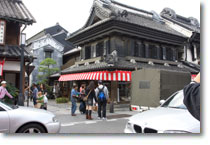
Today. Kawagoe has many traditional buildings that offers just the scenery of Edo period in modern world. Those traditional building are called "Mise-Gura." Mise-Gura is a store converted from storage. They are also called "Kura-zukuri," literary means "a house made from Storage." In 1893, there was a huge fire disaster that burnt down the entire city. However, after the disaster, those Kura survived from the fire. After that, all merchant started used their Kura as their store because they were fireproof building. Those Kuraz-ukuri are still preserved in great condition and most of the stores are still used.The main street of Kawagoe has the largest number of Kura-zukuri in such a small area in Japan. Some of Kura-zukuri is over 200 years old. The scenery of Kura-zukuri is fair enough to consider Kawagoe as "Little Edo" even today.
Tour starts at Kawagoe Station. Walk north about 15 min. Kura-zukuri Street that is the main street of Kawagoe. There are many gift shops, restaurants, fashion & accessories stores, food stands and craft shops, and all of them use Kura-zukuri. In the middle of Kura-zukuri street, there is a pass leading to "Tokinokane." It's a tower of time chime and symbol of Kawagoe. The tower was reconstructed in 1893 after the fire disaster. At the end of Kura-zukuri street there is "Kashiya Yokocho." Kashiya-Yokocho is a small district of wholesale stores of Japanese snacks. Those snacks are called "Dagashi." Dagashi is typical low price snacks from Showa era. Each stores have great collations of Dagashi.
After checking out the taste of Showa era, the next spot is the palace of Kawagoe Castles. It is located east side of Kashiya Yokocho. Most of the structures of Kawagoe Castle have been lost, but the palace of main bailey remains original building. It was built in 1848. Kawagoe Castle is chosen as one of 100 best castles and 7 greatest castle of Kanto. Most of palaces of Japanese castles are lost, and the palace of Kawagoe Castle is only few remaining one in Japan.
The last spots of Kawagoe is Kitain Temple. Kitain is located south side of Kawagoe Castle. Kitais is one of the oldest temple in Kanto. It was established in 830 by priest Ennin. There are many old building that are registered as historical important assets. The Japanese garden of Kitain has also stunning view. One building was removed from Edo castle in 1638. Therefore, there is a room of the birthplace of 3rd Tokugawa Shogun Iemitsu. Another feature of Kitain is 500 Rakan Statues. 500 Rakan Statues were made from 1782 to 1825. There are 538 statues and each one of them has different face and facial expression. Legend said, there is always one looks just like you.
Then, back to Kawagoe Station. This is one-day walking tour that offers time traveling to Edo period. When you visit Kawagoe in October, there is Kawagoe Matsuri that is one of major Dashi, parade floats, Matsuri in Kanto. It is very exciting festival in Kanto.
Kawagoe (川越) is also known as little Edo “Koedo.” About 6 million travelers visit Kawagoe, and one of the biggest travel spot in Saitama. This city has developed as the important defense line to protect Edo city, and also developed very similar town of Edo. Moreover, because many classic houses which survived from big fire in 1893, people still use those classic houses for restaurants and any other kinds of shops. This street is called “Kurazukuri.” Therefore, the town still looks like little Edo. Also, There are many historical temple like Kitain Temple.
Tourist Info.
At Kurazukuri Street, there is Jinrikisha service for tourist.
Access
0. at Kawagoe Station.
1. walk north (5 min.)
3 hr.